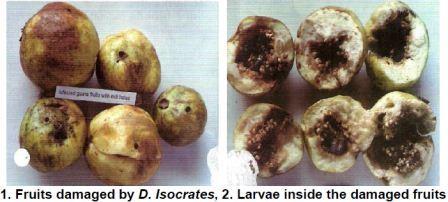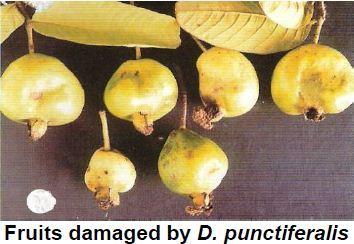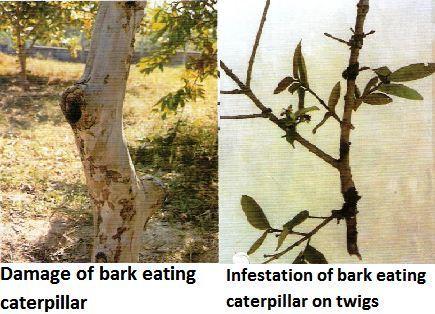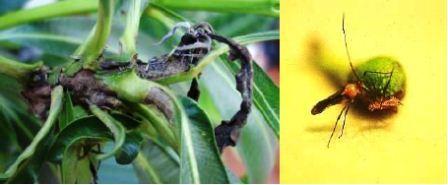Guava: Insect and Pest Management
Guava: Insect and Pest Management
Fruit fly
Biology:- Egg: Under optimum conditions, a female can lay more than 3,000 eggs during her lifetime, but under field conditions from 1,200 to 1,500 eggs per female is considered to be the usual production. Development from egg to adult under summer conditions requires about 16 days.
- Larva: The mature larva emerges from the fruit, drops to the ground, and forms a tan to dark brown puparium.
- Pupa: Pupation occurs in the soil. About nine days are required for attainment of sexual maturity after the adult fly emerges.
- Adult: Brown or dark brown with hyaline wings and yellow legs.

- Adults and maggots attack semi – ripe fruits
- Oviposition punctures on fruits
- Maggots destroy and convert pulp into a bad smelling
- Discoloured semi liquid mass
Guava fruit borers/ pomegranate butterfly
Biology:
- Eggs: Eggs are laid singly on tender leaves, stalks and flower buds.
- Larvae - Dark brown, short and stout, covered with short hairs, larval period lasts for 18-47 days.
- Pupa: Development occurs either inside the damaged fruits or on the stalk holding it. Pupal period lasts for 7-34 days. Total life cycle is completed in 1 to 2 months.
- Adult - bluish brown butterfly, Female – V shaped patch on forewing

- Caterpillar/larva bores into young fruits.
- Feeds on internal contents (pulp and seeds) making the fruit hollow from inside.
- Fruit rotting and dropping
Natural enemies of fruit borers: Parasitoids: Trichogramma chilonis, Tetrastichus spp., Telenomus spp., Chelonus blackburni, Carcelia spp. Campoletis chlorideae, Bracon spp. Predators: Chrysoperla, Rove beetles, Spiders, Coccinellids, Robber fly, Dragonfly, Reduviid bug, Praying mantis, Fire ants, Big eyed bugs, Pentatomid bug, Earwigs, Ground beetles, common mynah and King crow.
Castor capsule borer
Biology:- Egg: Pink colored eggs laid singly on flower buds, or young capsules.
- Larva: Pale reddish brown with black blotches and tubercles on body.
- Pupal: Pupates on plants in stem or capsule.
- Adult: Yellow colored moth with black dots.
 Stem dries up as larva bores in to it and them damages capsules.
Stem dries up as larva bores in to it and them damages capsules. - Caterpillar bores into young fruits but they may also bore buds and tender shoots.
- Feeds on internal contents (pulp and seeds)
- Infected fruits dry up and fall off without ripening
- The affected fruits are generally deformed at the point of entry of larvae.
- Larvae faeces may be seen exuding out of the borer hole. Such fruits weaken, rot and drop down.
Bark eating caterpillar
Biology:
- Eggs: Eggs are laid under loose bark or in cracks and crevices in clusters of 15-25 from April to June. Eggs hatch in 8-11 days. Eggs are oval in shape and reddish in colour.
- Larval: Caterpillars are pinkish white with brown spots and are about 40mm long. Larval duration is of 8-10 months.
- Pupal: Pupae are chestnut-brown in colour and 22 to 28 mm long, Pupal period is 21- 41 days. Total life cycle lasts 4-5 months in south India and more than a year in north India. One generation per year.
- Adult: Moths are white with pairs of small black dots on thorax, numerous small black spots and streaks on fore wings and few black spots on posterior edges of hind wings.

- The infestation of the pest may be identified by the presence of irregular tunnels and patches covered with silken web consisting of excreta and chewed up wood particles on the shoots, branches, stem and main trunk.
- Holes on the trunk, Wood dust and faecal matter hanging in the form of a web around the affected portion.
- Severe damage can result in the death of attacked stem. Blackish larva can be observed underneath the fresh webbing.
- Shelter holes may also be seen particularly at the joints of shoots and branches.
- The young shoots dry and die away giving sickly look to the plant
Tea mosquito bug
Biology:- Eggs: Eggs are elongate and slightly curved with a pair of filaments, egg period 7-8 days.
- Nymph: Nymphal period 14-16 days. Life cycle completed in 22-25 days.
- Adult: Reddish brown bug with black head, red thorax, black and white abdomen, and a knob like process on mid-dorsal thorax.

- Nymphs and adults make punctures on petiole, tender shoots and fruits
- Brownish – black necrotic patches develop on the foliage
- Elongate streaks and patches develop on shoots
- Corky scab formation on fruits.
Natural enemies of tea mosquito bug: Predators: Reduviid bug, Oxyopes sp. and Green lacewing.
Mealy bug
Biology:- Egg: The egg period was 28-32days. Female and male adults live for 23 to 28 days, respectively. Pre-oviposition, oviposition and post-oviposition periods is 6-7, 8.-9and 1-2 days, respectively. The total life span of female and male 46 -49nd 23 -29 days. The reproduction took place both sexually as well as parthenogenetically and female laid an average of 155 eggs during its life period.
- Nymph: Yellow to pale white in colour. Three to four nymphal instars and that the total nymphal period is 21 to 29 days.
- Adult: Females apterous, long, slender covered with white waxy secretions, The life-span of the adult female is 12-31days

- The tiny small bugs usually suck sap from twigs, leaves and flowers. Infested fruits will have uneven shapes, poor quality, and are susceptible to secondary infections by pathogens.
- The maximum temperature had significant positive correlation with the build-up of population of mealy bugs while high humidity had significant negative correlation. The other meteorological parameters, i.e. minimum temperature, relative morning humidity and rain, had no significant influence on the incidence of the pests.
- A major pest of several vegetables, ornamental plants, tropical orchard trees and was observed feeding on 76 species of plants belonging to 33 families.
Natural enemies of mealy bug: Predators: Chrysoperla carnea, Cryptolaemus montrouzieri, and Spalgis epius Parasitoids: Aenasius advena.
Aphid
Biology:- Eggs: Eggs are very small white to dull white in cloured layed on Both winged and wingless forms breed parthenogenetically.
- Nymph: The nymphal period lasts for 7-9 days.
- Adult: Adults live for 2-3 weeks and produce 8-22 nymphs per day. Entire life cycle takes 22-25 days. It has 12-14 generations per year.
- Nymphs and adults suck the sap from leaves, shoots and fruits
- Yellowing of leaves
- Wilting of terminal shoots
- Damage is severe because the green citrus aphid colonizes young shoots, buds, grafts and young plants, the development of which is inhibited. Spring-time attacks are the most deleterious.
Natural enemies of mealy bug: Predators: Scymnus, Chilomenes sexmaculatus, Chrysoperla carnea, Predatory mantids, parasitic wasps, ladybird beetle, predatory mite.
Whitefly
Biology:- Egg: The female white flies lay eggs singly on the underside of the leaves. Eggs are smooth, sub elliptical, stalked at broader basal end. Its colour is light yellow, when freshly laid, turn dark brown later on. The eggs hatch in 5-17 days.
- Stalked Nymph: It is louse like, sluggish creature having pale-yellow body. The nymphal stage lasts 14 to 81 days.
- Pupa: Convex in shape and possesses deep yellow patches on the abdomen.
- Adult: In 2-8 days, the pupae change into white flies.Adult fly is small winged insect having light yellow body of 1.0-1.5mm length dusted with a white waxy powder. Wings are pure white and have prominent long legs. The life cycle is completed in 14-122 days. Eleven generations of this pest are completed in a year.
Favorable conditions: The temperature of 28-360 C and 62-92% relative humidity and scanty rainfall during August to January are quite favorable for this pest.
Damage symptoms:- Chlorotic spots
- Yellowing
- Downward curling and drying of leaves.
- Vector of potato leaf curl disease
IPM for Guava
To know the IPM practices for Guava, click here.
Source: NIPHM and Directorate of Plant Protection, Quarantine & Storage
Last Modified : 2/13/2020
This topic covers the information related to insec...
This topic covers the information related to Insec...
This topic covers information about Ber Insect and...
This topic provides information about Loquat Inse...
